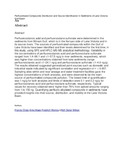Perfluorinated Compounds Distribution and Source Identification in Sediments of Lake Victoria Gulf Basin
Date
2011-03-03Author
Orata, Francis
Maes, Anke
Werres, Friedrich
Wilken, Rolf Dieter
Metadata
Show full item recordAbstract
Perfluorooctanoic acid and perfluorooctane sulfonate were determined in the sediments from Winam Gulf, which is in the Kenyan side of Lake Victoria and in its source rivers. The sources of perfluorinated compounds within the Gulf of Lake Victoria have been identified and their levels determined for the first time, in this study, using SPE and HPLC-MS-MS analytical methodology. Variability in the concentrations of perfluorooctanoic acid and perfluorooctane sulfonate ranged from 1.4–99.1 and <1–57.5 ng/g in river sediments, respectively, which was higher than concentrations obtained from lake sediments (range perfluorooctanoic acid <1–24.1 ng/g and perfluorooctane sulfonate <1–4.0 ng/g). The results obtained suggested generalized point sources such as domestic and industrial waste indicated by significant correlation and regression of r2 = 0.857. Sampling sites within and near sewage and water treatment facilities gave the highest concentrations of both analytes, and were observed to be the main source of perfluorinated compounds pollution. The lowest limit of quantification was 1 ng/g for both analytes and limits of detection were 0.1 and 0.2 ng/g for perfluorooctanoic acid and perfluorooctane sulfonate, respectively. Typical values for recovery obtained were higher than 78% from spiked amounts ranging from 1 to 150 ng. Quantifying perfluoro alkylated compounds in sediments have provided insights into their source, distribution, and mobility in the Lake Victoria Basin.
URI
https://doi.org/10.1080/15320383.2011.546442https://www.tandfonline.com/doi/full/10.1080/15320383.2011.546442
http://r-library.mmust.ac.ke/123456789/1653
Collections
- Gold Collection [1026]

